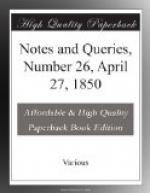“Enough for me, if to some feeling
breast
My lines a secret sympathy
impart;
And as their pleasing influence flows
confest,
A sign of soft reflection
heave the heart.” {417}
This, it will be seen, is prosaic enough; but the correspondent of the E. Mag. supposes the lines to have ended differently; and that the poet, in some peculiar fit of modesty, tore off the name. His version is this:—
“Enough for me, if to some feeling
breast,
My lines a secret sympathy
convey;
And as their pleasing influence
is imprest,
A sigh of soft reflection
heave for Gray.”
One word upon another poet, Byron v. Tacitus, in p. 390. of your 24th Number. There can be no doubt that the noble writer had this passage of Tacitus in his mind, when he committed the couplet in question to paper; but, in all probability, he considered it so well known as not to need acknowledgment. Others have alluded to it in the same way. The late Rev. W. Crowe, B.C.L., of New College, Oxford, and public orator of that University, in some lines recited by his son at the installation of Lord Grenville, has the following:—
“And when he bids the din of war
to cease,
He calls the silent desolation—peace.”
I wonder where Lord Byron stole stanzas 1, 2, 3, 4, of the second canto of The Bride of Abydos; to say nothing of some more splendid passages in the first and second cantos of Childe Harold?
W. (1.)
* * * * *
REPLIES TO MINOR QUERIES.
Chapels.—Perhaps the following remarks will be of service to “Mr. GATTY” in the solution of his Queries touching the word Chapel (No. 21.).
Spelman (Glossary, sub voce) endeavours to convince us that capella is the same as capsella, the diminutive of capsa; thus making chapel, in the first instance, “a small repository” (sc. of relics). Richardson is also in favour of this etymon, notwithstanding its harshness and insipidity. I think the common derivation (from capella, diminutive of capa) very much preferable to any other, both on the score of philology and of history. Ducange has quoted several passages, all tending to evince that capella (explained by the Teutonic voccus) was specially applied to the famous vestment of St. Martin, comprising his cloak and hood (not merely his hat, as some writers mention). The name was then metonymically transferred to the repository in which that relic was preserved, and afterwards, by a natural expansion, became the ordinary designation of the smaller sanctuaries. This derivation is distinctly affirmed by Walafred Strabo about 842, and by a monk of St. Gall, placed by Basnage about 884. The earliest instance where




